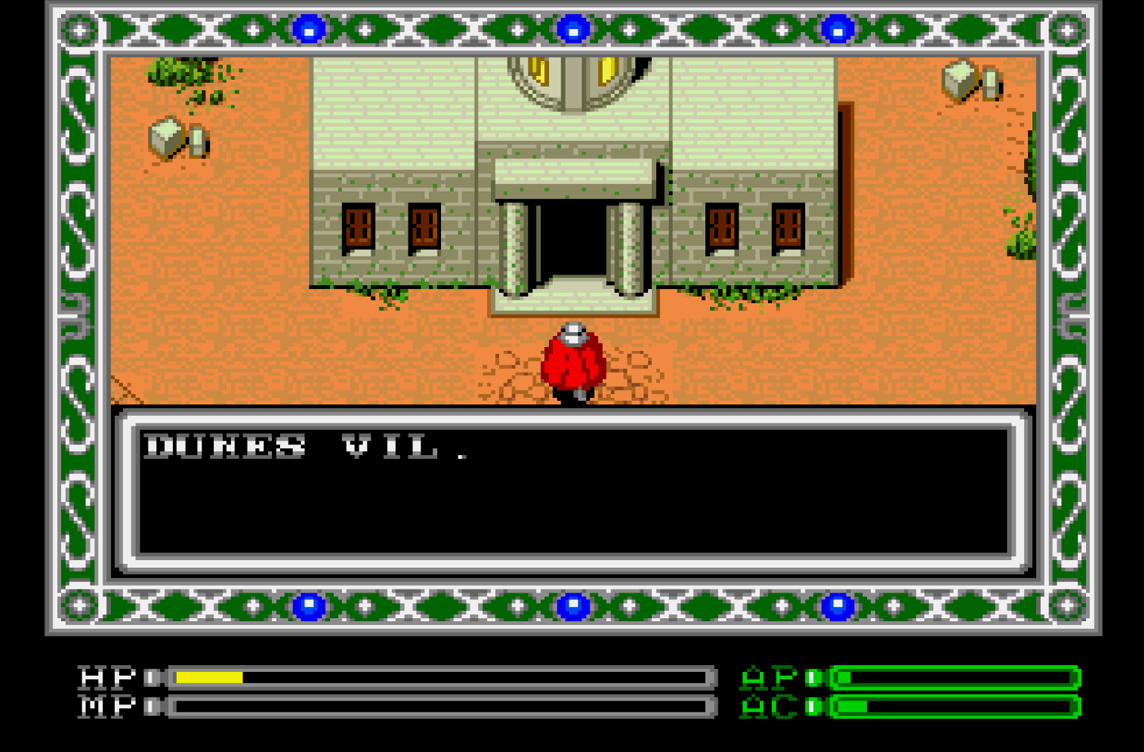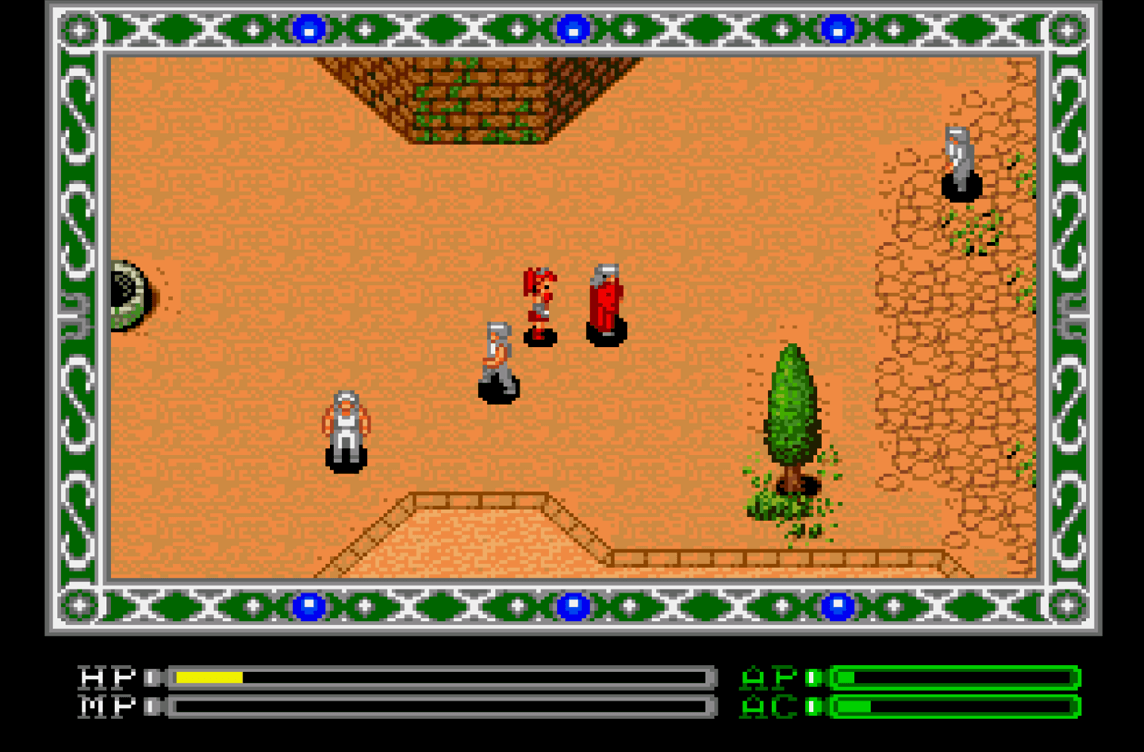Exile, an action RPG developed in the early ’90s, found its publisher in Renovation. Amidst a diverse array of Genesis titles, Exile emerged as a standout, offering a unique blend of gameplay elements. While it may not have gained the same level of notoriety as some of its contemporaries, it certainly merits a closer look.
A Hero’s Journey
The game’s narrative centers around Sadler, a celebrated desert hero, who has previously led a revolt against a formidable superpower. The dust of war had barely settled when a new threat emerged from the rival country of Luciel, setting the stage for another epic conflict. To defend his homeland, Exile, Sadler seeks to amass an army, beginning his quest at a desert fortress.
What ensues is an odyssey that transports players to uncharted territories, weaving a tale of bravery, conflict, and destiny. The plot, while occasionally hindered by nuances in translation, offers unexpected depth beyond the typical “rescue the princess/world” trope often found in RPGs of the era.
Visual Dualism
Exile presents players with two distinct visual experiences. The overworld map, initially appearing deceptively simple, reveals hidden intricacies upon closer inspection. Though dominated by solid colors, discerning eyes will uncover subtle details in various objects and locales.
Shading, ranging from rudimentary to intricate, imparts depth to the environment. Character animations, adhering to the customary three-frame structure, maintain a respectable level of detail despite their smaller stature.
However, it is in the side-scrolling action platformer mode that Exile truly shines visually. The graphics undergo a notable upgrade, featuring enhanced shading, smoother character animations, and refined details such as flickering torches and falling snow.
Characters, rendered at a larger scale, allow for more intricate designs. While the level layouts exhibit a straightforward approach, some later stages introduce labyrinthine mazes, adding an extra layer of challenge. Although parallax scrolling is somewhat limited, the backgrounds, predominantly set in dungeons and caves, compensate with their atmospheric aesthetics.
Interwoven throughout the game are brief yet engaging cut scenes. While not particularly elaborate, they effectively contribute to the narrative. Collectively, Exile’s visual presentation, while not without its minor disparities between the two modes, stands as a commendable achievement for a title released in 1991.
Harmonious Melodies
The auditory landscape of Exile, though not without its quirks, enriches the overall experience. Sound effects, primarily prominent during action sequences, range from the resonant clash of swords to the demise of adversaries. While some effects may seem unconventional, they complement the gameplay dynamics effectively.
Music takes center stage in Exile, offering compositions that span a spectrum of moods, from the infectious to the contemplative. Noteworthy is the infusion of hip-hop influences in several tracks, a stylistic choice that, while initially surprising given the game’s setting, grants the music a distinct character.

This unconventional blend is offset by elements of Arabic and Oriental motifs, aligning more closely with the game’s cultural backdrop. While certain instrument choices may not universally appeal, none veer into grating territory, resulting in a musically engaging experience.
Gameplay Dynamics and Nuances
Exile encompasses the hallmark elements of RPG gameplay. Progress hinges on interactions with non-playable characters (NPCs), procurement of superior weaponry and armor, and acquisition of vital items.
Players initially command a party of four characters, with the composition subject to regular alterations as the narrative unfolds. The ability to save progress at any juncture on the overworld map provides a welcome convenience. Character progression, achieved through experience gained from vanquishing foes, follows a familiar RPG trajectory.
Combat, a departure from the conventional turn-based approach, transitions to a side-scrolling action platformer mode. Players are equipped with a repertoire of actions, including sword swings, leaps, aerial slashes, and downward strikes.
These maneuvers, executed seamlessly through responsive controls, provide a dynamic combat experience. Magic augments the arsenal, offering an alternative means to engage adversaries. Furthermore, restorative items and temporary enhancements for attack and defense supplement the combat strategy.
Challenges and Quirks
While Exile admirably navigates the RPG landscape, it is not impervious to minor hiccups. Chief among these is the phenomenon of enemy respawning, a feature that, while conducive to facile leveling in some instances, can prove vexing during precarious situations or platforming segments.
Hit detection, particularly when combating aerial adversaries, occasionally displays discerning tendencies, wherein the crescent arc of the sword’s swing appears to make contact inconsistently.
Accompanying these considerations are intermittent visual and auditory glitches. Transitions between stages manifest as rapid screen flickers, akin to the behavior of older DOS games on sluggish hardware. Sound discrepancies occasionally arise, with instruments undergoing subtle alterations in tonality during certain menu interactions.
Backtracking, predominantly evident in the latter stages, constitutes another minor quirk. While not excessively burdensome, it prompts reflection on the necessity of this design choice. Furthermore, occasional dialogue passages deviate from coherence, exhibiting prolixity or occasional ambiguities. These anomalies punctuate an otherwise coherent narrative.

Noteworthy is the limited agency afforded to auxiliary characters. Although they traverse alongside Sadler, their role is largely peripheral, as the narrative seldom necessitates their direct involvement. The absence of meaningful interaction with these characters may leave players yearning for deeper engagement.
Conversely, attentiveness to NPC dialogue proves paramount, as Exile occasionally offers subtle cues that elicit crucial insights. The game’s information dissemination could benefit from a more transparent approach, as some pivotal details may elude casual observation.
Final Verdict: Navigating the Sands of Exile
In summary, Exile strikes a harmonious balance between its merits and idiosyncrasies. While it may not ascend to the echelons of greatness, it delivers an engaging experience for those who explore its intricacies.
The game transcends the binary classification of exemplary or deficient, opting instead for a steady trajectory that neither plummets nor soars. Exile is a hidden gem that, given the opportunity, will captivate players for four to five hours, securing a place as a noteworthy entry in the Genesis library.
Embark on a desert journey, where heroism meets conflict in the world of Exile.
Play Exile Online Anywhere, Anytime!
Experience Exile on our website or on your mobile and tablet devices.